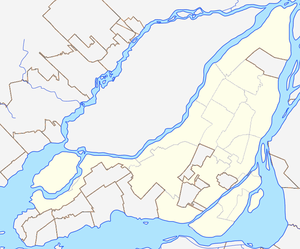Trafalgar School for Girls
| Trafalgar School for Girls | |
|---|---|
| Address | |
 Trafalgar School for Girls  Trafalgar School for Girls  Trafalgar School for Girls | |
|
3495 Simpson, Montréal, Québec H3G 2J7 Montreal Canada | |
| Coordinates | 45°29′56″N 73°35′03″W / 45.4988°N 73.5841°W |
| Information | |
| Website |
trafalgar |
Trafalgar School for Girls (Traf) is a private anglophone secondary school in Downtown Montreal, Quebec. The school serves students at Secondary I - V levels, i.e. ages 11–12 to 16-17. The total enrollment is 200, the student-teacher ratio is 8:1, and the average class size is a range from 10 to 20.[1]
The site is within the Golden Square Mile, which, when the school opened in 1887, was the richest neighbourhood in Canada.[2] The idea came from a wealthy merchant named Donald Ross. The institute received funds from Anne Scott and Donald Smith, 1st Baron Strathcona and Mount Royal and other prominent residents of Montreal.[2][1] The school's curriculum was designed to prepare girls for higher education, although only a small minority actually went to university.[3]
The Montreal Hoshuko School, a weekend Japanese school, rents classroom space there.[4][5]
Notable former pupils
- Vivien Law, linguist and academic
References
- 1 2 "Profile of Our School." Trafalgar School for Girls. Retrieved on March 30, 2014.
- 1 2 Kalbleisch, John (22 September 2012). "Trafalgar School has long history". Montreal Gazete.
- ↑ Meadowcroft, Barbara (1999). the Beaver Hall Women Painters. Montreal: Veihicule press. pp. 25, 29, 41, 54, 65, 107, 109, 146, 147.
- ↑ "所在地." Montreal Hoshuko School. Retrieved on March 30, 2014. "【住所】 3495 Simpson, Montréal, Québec H3G 2J7 c/o Trafalgar School for Girls"
- ↑ Maguire, Mary H. (McGill University). "Identity and Agency in Primary Trilingual Children’s Multiple Cultural Worlds: Third Space and Heritage Languages" (Archive). In: Cohen, James, Kara T. McAlister, Kellie Rolstad, and Jeff MacSwan (editors). ISB4: Proceedings of the 4th International Symposium on Bilingualism. Conference held from April 30 to May 3, 2003. Published May 2005. p. 1423-1445. CITED: p. 1432 (PDF p. 10/24). "The other two schools, the Chinese Shonguo and Japanese Hoshuko are privately funded, rent space for their Saturday schools from mainstream educational institutions, and thus have no visible identifiable logo or physical presence as a particular ”heritage language school”."
External links